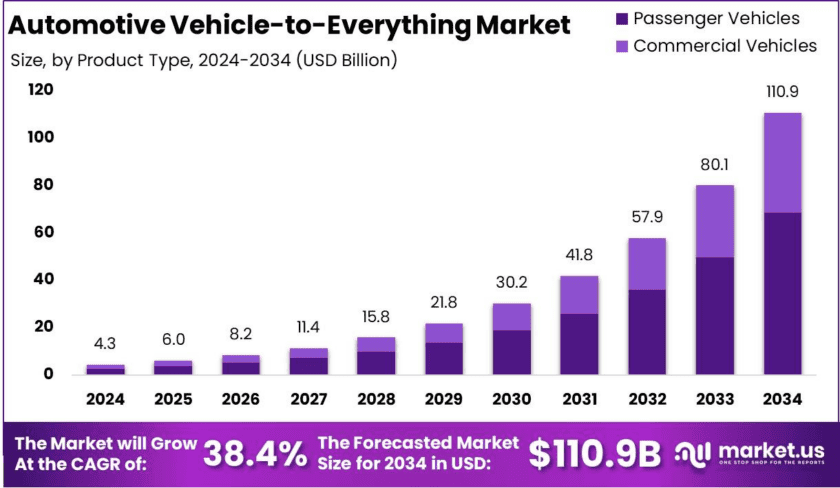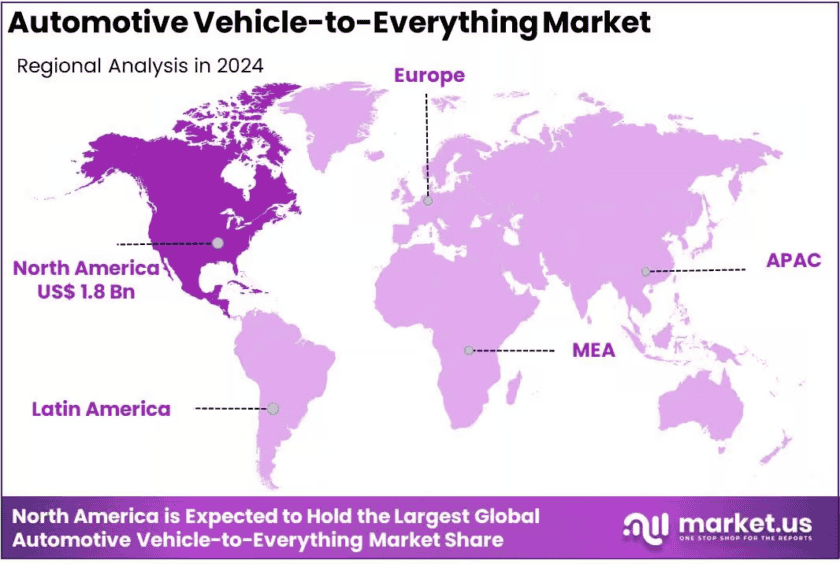Table of Contents
Introduction
Global Automotive Vehicle-to-Everything Market is projected to reach approximately USD 110.9 billion by 2034, up from USD 4.3 billion in 2024. This represents a compound annual growth rate (CAGR) of 38.4% over the forecast period from 2025 to 2034.
The concept of Automotive Vehicle-to-Everything (V2X) encompasses a broad communication model that enables vehicles to transmit information to any entity that may affect the vehicle, and vice versa. This technology is foundational to enhancing road safety, traffic efficiency, and energy savings in the context of intelligent transportation systems. The Automotive V2X market refers to the commercial landscape surrounding the development, distribution, and implementation of these technologies.
Growth in this market is primarily driven by the escalating demand for safer road systems, increased adoption of connected cars, and supportive government policies promoting vehicle communication systems for public safety. Furthermore, the surge in demand is also fueled by the integration of V2X systems with emerging technologies such as 5G, which significantly enhances vehicle communication capabilities. Opportunities within this sector are vast, with potential for expansion into new regions and integration with smart city projects, which aim to capitalize on the technology’s ability to manage traffic flow and reduce congestion.
The market’s trajectory suggests robust growth, supported by continual advancements in technology and a strong push from regulatory bodies to implement these systems to reduce traffic incidents and improve road safety. As industries and governments increasingly recognize the benefits of connected vehicle technologies, the Automotive V2X market is poised for significant expansion, presenting substantial opportunities for stakeholders across the automotive and technology sectors.

Key Takeaways
- The Automotive Vehicle-to-Everything Market is projected to grow from USD 4.3 billion in 2024 to USD 110.9 billion by 2034, indicating a Compound Annual Growth Rate (CAGR) of 38.4% during the forecast period from 2025 to 2034.
- The Passenger Vehicles segment is expected to dominate the market, with a projected market share of over 62% in 2024.
- Dedicated Short-Range Communications (DSRC) technology is anticipated to be the preferred connectivity type, underlining its dominance in the market.
- The Software component is expected to hold a majority share, accounting for more than 57% of the market in 2024
- Vehicle-to-Vehicle (V2V) communication is poised to capture the largest market share, estimated at 44.7% in 2024.
- North America is set to lead the V2X market, holding a significant market share of 42.6% in 2024, which translates to USD 1.8 billion.
Automotive Vehicle-to-Everything Statistics
- Global electric vehicle (EV) sales reached 14 million in 2023, up from 10.5 million in 2022.
- Lithium-ion batteries, which power EVs, are responsible for 40-60% of the vehicles’ total production emissions.
- EVs used about 130 terawatt-hours (TWh) of electricity in 2023, making up 0.5% of global electricity use and displacing 0.9 million barrels of oil per day.
- To achieve net-zero emissions by 2030, EVs need to offset approximately 8.2 million barrels of oil daily.
- Electric vehicles are key to cutting down over 15% of global energy-related emissions from road transport.
- Major automakers like Volvo, BMW, and Ford plan to reach carbon neutrality by 2040 or earlier.
- In the U.S., SUV sales have surpassed sedan sales, which have decreased by 25% in the last five years.
- Car prices typically rise by 10-15% during the peak seasons of March to May and September to November.
- 92% of car buyers research online before purchasing.
- 60% of buyers watch a car video before visiting the website or dealership.
- 25% of drivers prefer hybrid vehicles due to gasoline costs.
- 53% of car purchases are now made online, indicating a significant trend towards digital buying.
Emerging Trends
- Integration with Smart City Infrastructure: As urban areas evolve into smart cities, V2X technology is becoming crucial in improving traffic management and road safety.
- Advancements in Autonomous Vehicles: The technology plays a pivotal role in the development of autonomous driving, enhancing vehicle communication with other vehicles and infrastructure.
- Increased Adoption of DSRC and C-V2X Communication Technologies: Dedicated Short-Range Communication (DSRC) and Cellular Vehicle-to-Everything (C-V2X) are gaining traction due to their reliability and support from government regulations.
- Growth in Electric Vehicles (EVs): V2X is integral in supporting EV infrastructure, particularly for energy management between vehicles and the power grid.
- Expansion of AI and Machine Learning: These technologies are being leveraged to enhance data analytics capabilities within V2X systems, improving real-time decision-making processes.
Top Use Cases
- Enhanced Road Safety: V2X technology is used to reduce accidents by allowing vehicles to communicate potential hazards with each other and with road infrastructure.
- Traffic Flow Optimization: It aids in managing and directing traffic more efficiently, reducing congestion.
- Emergency Vehicle Notification: V2X can prioritize traffic flow for emergency responders, improving response times.
- Fleet and Asset Management: For commercial uses, V2X helps in tracking and managing vehicle fleets efficiently.
- Environmental Monitoring: Vehicles can collect and transmit environmental data, aiding in urban planning and management.
Major Challenges
- High Initial Investment: The costs associated with implementing V2X technology can be substantial.
- Cybersecurity Risks: As vehicles become more connected, the risk of cyberattacks increases, necessitating robust security measures.
- Interoperability Issues: Ensuring that V2X systems from different manufacturers can work together is challenging.
- Regulatory and Standardization Hurdles: The lack of unified standards across different regions can complicate deployment.
- Technology Adoption Rates: The pace of adoption can vary significantly across different regions due to economic and infrastructural factors.
Top Opportunities
- Government Initiatives: Many governments are supporting V2X technology through regulations and funding, particularly in regions like Europe and Asia.
- Partnerships with Technology Providers: Collaborations between automotive manufacturers and technology firms can accelerate innovation and adoption.
- New Business Models: V2X opens up opportunities for new services and business models, particularly in data analytics and fleet management services.
- Global Market Expansion: As emerging markets develop their vehicle infrastructures, new opportunities for V2X solutions arise.
- Enhanced Consumer Demand for Safety and Efficiency: Increasing consumer awareness and demand for safer and more efficient vehicles drive market growth.
Key Player Analysis
Global Automotive Vehicle-to-Everything (V2X) Market in 2024, several key players are expected to drive advancements and market growth. Denso Corporation and Continental AG are anticipated to leverage their strong automotive and technology integration capabilities to enhance V2X applications. Similarly, Qualcomm Technologies, Inc., with its robust portfolio in wireless communications, is poised to remain a pivotal player in the connectivity solutions pivotal for V2X technologies.
Infineon Technologies AG and NXP Semiconductors are expected to further their impact by providing critical semiconductor solutions that facilitate reliable and secure communications in automotive environments. Aptiv and Harman International, recognized for their innovative automotive electronics, are likely to expand their V2X offerings, aligning with the increasing demand for connected vehicle solutions.
Smaller specialists like Autotalks Ltd. and Cohda Wireless are projected to contribute significantly with their dedicated V2X and communications expertise, potentially collaborating with larger automotive firms like Ford Motor Company and Robert Bosch GmbH to integrate V2X technologies into mainstream vehicle platforms. Companies like Savari Inc., Kapsch TrafficCom, and Lear Corporation, with their specialized capabilities, are expected to strengthen the infrastructure and support systems essential for V2X implementation.
Top Key Players
- Denso Corporation
- Aptiv
- Infineon Technologies AG
- Continental AG
- Qualcomm Technologies, Inc.
- Autotalks Ltd.
- Cohda Wireless
- Kapsch TrafficCom
- Savari Inc.
- Lear Corporation
- LG Electronics
- Ford Motor Company
- Robert Bosch GmbH
- NXP Semiconductors
- Harman International
Regional Analysis
North America Leads the Automotive Vehicle-to-Everything Market with the Largest Market Share of 42.6%
In the automotive vehicle-to-everything (V2X) market, North America emerges as the dominant region, accounting for 42.6% of the global market in 2024. This region’s significant market share can be attributed to advanced technological integration and the widespread adoption of connected vehicle technologies among North American automotive manufacturers.
The market valuation for V2X technologies in North America reached USD 1.8 billion, underscoring the robust investment and development in this sector. Factors driving the market include supportive regulatory frameworks, high consumer demand for safety features, and the presence of key industry players who are pioneering the integration of V2X technologies. These elements collectively facilitate the growth and expansion of the V2X market in North America, positioning it at the forefront of the global industry landscape.

Recent Developments
- In 2024, Panasonic introduced Cirrus 2.0 at ITS America, an enhancement of their existing Cirrus platform. This new release extends their toolkit for vehicle-to-everything (V2X) management, aiming to assist state Departments of Transportation and commercial fleet operators with improved roadway mobility and safety. The system integrates seamlessly with various transportation infrastructure, supporting vehicles such as snowplows, emergency response units, and buses.
- In 2023, Qualcomm agreed to acquire the Israeli company Autotalks, a move set to bolster its portfolio in V2X communication technologies. This acquisition is designed to enhance Qualcomm’s Snapdragon Digital Chassis offerings, promoting safer and more effective vehicle communication systems across automotive and transportation sectors.
- In April 2024, DENSO Products and Services Americas, Inc. announced the launch of MobiQ at the ITS America Conference & Expo in Phoenix. MobiQ, which stands for mobility, intelligence, and quality, represents DENSO’s dedication to enhancing smart mobility solutions, contributing to safer and cleaner transportation of people and goods.
Conclusion
the Automotive Vehicle-to-Everything (V2X) market is poised for significant growth due to its critical role in advancing road safety, traffic management, and vehicle communication efficiencies. As governments and industries increasingly invest in and adopt this technology, coupled with the advancements in connected and autonomous vehicles, the market’s expansion is inevitable. The integration of V2X systems with smart city infrastructures and the increasing utilization of cutting-edge technologies such as artificial intelligence and machine learning further enhance its potential. Despite challenges like high initial costs and cybersecurity risks, the continuous support from regulatory bodies and the escalating demand for safer and more efficient transportation solutions ensure a dynamic growth trajectory for the V2X market. This ongoing evolution marks a transformative phase in transportation, promising enhanced safety and efficiency in the mobility ecosystem.
Discuss Your Needs With Our Analyst
Please share your requirements with more details so our analyst can check if they can solve your problem(s)





